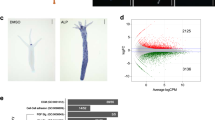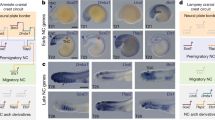Abstract
In mice, there is evidence suggesting that the development of head and trunk structures is organized by distinctly separated cell populations1,2. The head organizer is located in the anterior visceral endoderm (AVE) and the trunk organizer in the node and anterior primitive streak. In amphibians, Spemann's organizer, which is homologous to the node, partially overlaps with anterior endoderm cells expressing homologues of the AVE markers cerberus, Hex and Hesx1 (refs 3,4,5,6). For mice, this raises the question of whether the AVE and node are independent of each other, as suggested by their anatomical separation, or functionally interdependent as is the case in amphibians3,4,5. Chordin and Noggin are secreted bone morphogenetic protein (BMP) antagonists7,8 expressed in the mouse node, but not in the AVE. Here we show that mice double-homozygous mutants that are for chordin and noggin display severe defects in the development of the prosencephalon. The results show that BMP antagonists in the node and its derivatives are required for head development.
This is a preview of subscription content, access via your institution
Access options
Subscribe to this journal
Receive 51 print issues and online access
$199.00 per year
only $3.90 per issue
Buy this article
- Purchase on Springer Link
- Instant access to full article PDF
Prices may be subject to local taxes which are calculated during checkout



Similar content being viewed by others
References
Beddington, R. S. P. & Robertson, E. J. Axis development and early asymmetry in mammals. Cell 96, 195–209 (1999).
Tam, P. L. & Behringer, R. R. Mouse gastrulation: the formation of a mammalian body plan. Mech. Dev. 68, 3–25 (1997).
Bouwmeester, T., Kim, S. H., Sasai, Y., Lu, B. & De Robertis, E. M. Cerberus is a head-inducing secreted factor expressed in the anterior endoderm of Spemann's organizer. Nature 382, 595–601 (1996).
Piccolo, S. et al. Cerberus induces head structures by binding to and inhibiting Nodal, BMP and Wnt signals in the extracellular space. Nature 397, 707–710 (1999).
Zorn, A. M., Butler, K. & Gurdon, J. B. Anterior endomesoderm specification in Xenopus by Wnt/β-catenin and TGF-β signalling pathways. Dev. Biol. 209, 282–297 (1999).
Zaraisky, A. G. et al. The homeobox-containing gene XANF-1 may control development of the Spemann organizer. Development 121, 3839–3847 (1995).
Piccolo, S., Sasai, Y., Lu, B. & De Robertis, E. M. Dorsoventral patterning in Xenopus: Inhibition of ventral signals by direct binding of Chordin to BMP-4. Cell 86, 589– 598 (1996).
Zimmerman, L. B., De Jesús-Escobar, J. M. & Harland, R. M. The Spemann organizer signal noggin binds and inactivates bone morphogenetic protein 4. Cell 86, 599–606 ( 1996).
McMahon, J. A. et al. Noggin-mediated antagonism of BMP signaling is required for growth and patterning of the neural tube and somite. Genes Dev. 12, 1438–1452 ( 1998).
Chiang, C. et al. Cyclopia and defective axial patterning in mice lacking Sonic hedgehog gene function. Nature 383, 407–413 (1996).
Oliver, G. et al. Six-3, a murine homologue of the sine oculis gene, demarcates the most anterior border of the developing neural plate and is expressed during eye development. Development 121 , 4045–4055 (1995).
Thomas, P. & Beddington, R. Anterior primitive endoderm may be responsible for patterning the anterior neural plate in the mouse embryo. Curr. Biol. 6, 1487–1496 (1996).
Dattani, M. T. et al. Mutations in the homeobox gene HESX1/Hesx1 associated with septo-optic dysplasia in human and mouse. Nature Genet. 19, 125–133 (1998).
Shawlot, W. & Behringer, R. R. Requirement for Lim1 in head-organizer function. Nature 374, 425–430 (1995).
Ang, S. L. & Rossant, J. HNF-3β is essential for node and notochord formation in mouse development. Cell 78, 561–574 (1994).
Rhinn, M. et al. Sequential roles for Otx2 in visceral endoderm and neuroectoderm for forebrain and midbrain induction and specification. Development 125, 845–856 ( 1998).
Dufort, D., Schwartz, L., Harpal, K. & Rossant, J. The transcription factor HNF3β is required in visceral endoderm for normal primitive streak morphogenesis. Development 125, 3015– 3025 (1998).
Belo, J. A. et al. Cerberus-like is a secreted factor with neuralizing activity expressed in the anterior primitive endoderm of the mouse gastrula. Mech. Dev. 68, 45–57 (1997).
Liu, P. et al. Requirement for Wnt3 in vertebrate axis formation. Nature Genet. 22, 361–365 (1999).
Litingtung, Y., Lei, L., Westphal, H. & Chiang, C. Sonic hedgehog is essential for the development of the foregut. Nature Genet. 20, 58–61 ( 1998).
Motoyama, J. et al. Essential function of Gli2 and Gli3 in the formation of lung, trachea and oesophagus. Nature Genet. 20, 54–57 (1998).
Meyers, E. N. & Martin, G. R. Differences in left–right axis pathways in mouse and chick: functions of FGF8 and SHH. Science 285, 403–406 ( 1999).
Hammerschmidt, M., Serbedzija, G. N. & McMahon, A. P. Genetic analysis of dorsoventral pattern formation in the zebrafish: requirement of a BMP-like ventralizing activity and its dorsal repressor. Genes Dev. 10, 2452– 2461 (1996).
Schulte-Merker, S., Lee, K. J., McMahon, A. P. & Hammerschmidt, M. The zebrafish organizer requires chordino. Nature 387, 862–863 (1997).
Lyons, K. M., Hogan, B. L. M. & Robertson, E. J. Colocalization of BMP 7 and BMP 2 RNAs suggests that these factors cooperatively mediate tissue interactions during murine development. Mech. Dev. 50, 71–83 (1995).
Arkell, R. & Beddington, R. S. P. BMP-7 influences pattern and growth of the developing hindbrain of mouse embryos. Development 124, 1–12 ( 1997).
Solloway, M. J. & Robertson, E. J. Early embryonic lethality in Bmp5; Bmp7 double-mutant mice suggests functional redundancy within the 60A subgroup. Development 128, 1753–1768 (1999).
Golden, J. A et al. Ectopic bone morphogenetic proteins 5 and 4 in the chicken forebrain lead to cyclopia and holoprosencephaly. Proc. Natl Acad. Sci. USA 54, 623–634 ( 1999).
Furuta, Y., Piston, D. W. & Hogan, B. L. M. Bone morphogenetic proteins (BMPs) as regulators of dorsal forebrain development. Development 124, 2203–2212 (1997).
Piccolo, S. et al. Cleavage of Chordin by the Xolloid metalloprotease suggests a role for proteolytic processing in the regulation of Spemann organizer activity. Cell 91, 407–416 (1997).
Acknowledgements
We thank R. Beddington, G. Oliver, D. Wilkinson and A. Joyner for gifts of plasmids, K. Woo, C. De Robertis, B. Yoon and A. Burnett for help with genotyping, and K. Lyons, G. Weinmaster, E. Delot and members of our laboratories for comments on the manuscript. This work was supported by the HHMI, NIH, MRC Canada, Whitehead Foundation and the Norman Sprague Chair.
Author information
Authors and Affiliations
Rights and permissions
About this article
Cite this article
Bachiller, D., Klingensmith, ., Kemp, C. et al. The organizer factors Chordin and Noggin are required for mouse forebrain development. Nature 403, 658–661 (2000). https://doi.org/10.1038/35001072
Received:
Accepted:
Issue Date:
DOI: https://doi.org/10.1038/35001072
This article is cited by
-
Highly conserved and extremely evolvable: BMP signalling in secondary axis patterning of Cnidaria and Bilateria
Development Genes and Evolution (2024)
-
A de novo splicing variant supports the candidacy of TLL1 in ASD pathogenesis
European Journal of Human Genetics (2020)
-
R-spondins are BMP receptor antagonists in Xenopus early embryonic development
Nature Communications (2020)
-
Transcriptome profiling reveals male- and female-specific gene expression pattern and novel gene candidates for the control of sex determination and gonad development in Xenopus laevis
Development Genes and Evolution (2019)
-
The effect of magnetic resonance imaging on neural tube development in an early chicken embryo model
Child's Nervous System (2018)
Comments
By submitting a comment you agree to abide by our Terms and Community Guidelines. If you find something abusive or that does not comply with our terms or guidelines please flag it as inappropriate.



